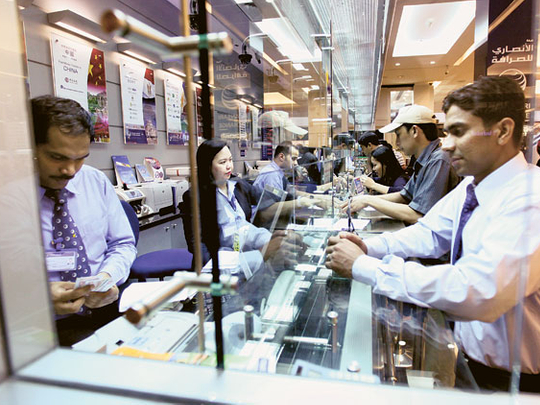
Much to their credit, the Gulf Cooperation Council (GCC) states are a major source of remittances in the world, particularly to south and south-east Asian countries. As such, millions of people in Asia depend for their well-being on money earned and remitted from GCC countries.
The collective remittances are estimated at a whopping $70 billion (Dh257 billion) in 2011, according to figures appearing in the Saudi press attributed to the World Bank.
The figure is sizeable, comprising about 7 per cent of gross domestic product (GDP) of the GCC countries.
Together, the six-nation grouping boasts a GDP of $1 trillion.
To be sure, the remittances from GCC countries comprise just above 17 per cent of the total outflow of remittances of $406 billion in 2011.
What is more, Saudi Arabia ranks second only to the US with regard to the amount of outflow of remittances, a fact that adds to the significance of the kingdom in the global economy.
Already, Saudi Arabia is the largest oil exporter in the world on the back of accounting for 13 per cent of total oil exports.
The World Bank statistics relating to 2011 put estimated remittances from Saudi Arabia at $27 billion, undoubtedly a gigantic amount.
The UAE follows with an outflow of $17 billion, followed by Kuwait with $13 billion. The sum remitted each from Qatar and Oman is estimated at $6 billion.
Still, the amount remitted from Bahrain stands at $2 billion, a sizeable amount accounting for 11 per cent of the country's GDP of $22 billion.
Contrast
By contrast, money remitted from Saudi Arabia accounts for about 6 per cent of the country's GDP.
GCC countries must exert efforts to encourage expatriates to invest a portion of their earned funds within the region if only to check size of remitted amounts.
Needless to say, funds invested in property and the bourses besides consumption end up circulating in local economies.
However, this is no easy job, as countries such as India and the Philippines offer their citizens attractive options in the form of special accounts and tax bonuses to attract remittances of hard currency.
In reality, both India and the Philippines cannot be blamed for seeking to attract a hefty $57 billion and $23 billion in remittances, respectively.
India leads the world in receiving remittances, far ahead of second-placed China by a margin of $1 billion, according to the recently released statistics.
The logic for the sizeable amount of funds remitted abroad is simple, judging by the number of foreign workers in the GCC economies.
Reference is to some 14 million immigrant workers in the GCC countries, the majority of whom originate from south and south-east Asia.
Together, the economies of Saudi Arabia and the UAE provide employment opportunities for some 10 million immigrant workers.
Dominant population
Not surprisingly, immigrant workers and their dependents comprise the majority of residents in all GCC countries except Saudi Arabia and Oman.
It is estimated that foreign nationals make up around 82 per cent of the population in the UAE and Qatar, 69 per cent in Kuwait and 52 per cent in Bahrain.
These hard facts add to the global status of the GCC economies for being uniquely receptive to workers from many parts of the world.
It is believed that nationals from more than 150 countries work and live in Dubai, something that adds to the emirate's global image. No wonder all roads are leading to Dubai.
The writer is a Member of Parliament in Bahrain.











